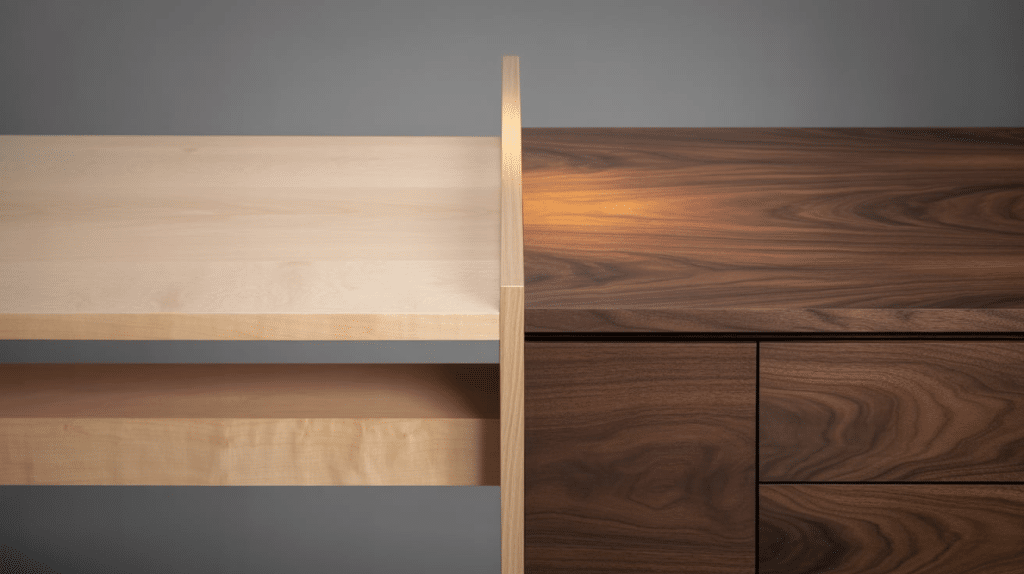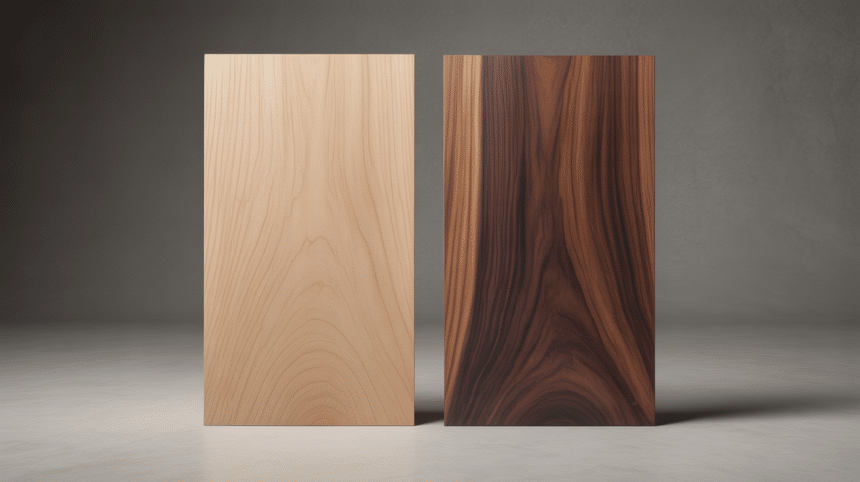Have you ever stood in a lumber yard scratching your head while comparing wood samples? You’re not alone. Choosing between maple and walnut is like picking between chocolate and vanilla ice cream, both great, just different.
These two popular woods are everywhere, from kitchen floors to fancy furniture. Each brings its personality to your space. Maple offers that bright, clean look, while walnut brings the rich, deep character many folks love.
Ready to settle the maple vs walnut debate once and for all? Let’s break down what makes each special and help you pick the right wood for your next project.
But don’t worry, this isn’t about making the “perfect” choice. It’s about finding the wood that feels right for your home and style. After all, both have stood the test of time for good reason.
Understanding Maple vs Walnut Cabinet Material
Maple and walnut are two of the most popular hardwoods used in furniture making, cabinetry, and flooring. Each has unique characteristics.
Maple Wood
Maple is a hardwood derived from several species of trees in the genus Acer. It is commonly found in North America, particularly in the northeastern and central regions.
There are two main types of maple: sugar maple, known for its syrup production, and soft maple, which is often used for woodworking.
Maple is recognized for its light, creamy color and subtle grain patterns. It is durable, dense, and has a fine texture, making it a popular choice for furniture, cabinetry, and kitchen items.
Walnut Timber
Walnut is a dark, dense hardwood sourced from the Juglans genus. Black walnut is the most prized species for woodworking. Native to North America, the walnut is well-known for its rich, dark brown color, often with streaks of purplish hues.
Walnut has a distinctive, straight grain with a smooth texture, making it highly desirable for fine furniture, cabinetry, and luxury interior accents.
Comparing Maple and Walnut

Maple and walnut are popular wood choices for furniture, cabinetry, and woodworking. Each has distinct features, including appearance, durability, workability, and cost.
Understanding their differences can help you make an informed decision based on your needs and preferences.
Appearance and Appeal
When it comes to appearance, maple and walnut offer quite distinct looks, each suited for different aesthetics.
- Color: Maple is lighter in tone, ranging from pale cream to light brown, giving it a bright and airy appearance. In contrast, walnut is darker, with rich brown shades tinged with dark purples or charcoal, offering a luxurious and warm look.
- Texture: Maple has a smooth, even texture ideal for sleek, modern designs, while walnut has a more varied texture, often with wavy or straight grain patterns, making it perfect for furniture that aims to create a dynamic, rich atmosphere.
- Grain: Maple’s fine, uniform grain contributes to a minimalist aesthetic. Walnut’s bold, distinctive grain adds depth and character, giving it a more textured and dynamic appearance.
Durability and Strength
Both maple and walnut are durable, but their specific hardness and resilience differ.
- Hardness: Maple, particularly hard maple, has a higher Janka hardness rating than walnut, making it more resistant to dents and scratches. This makes it a better choice for high-traffic areas or furniture that sees frequent use.
- Resilience to Damage: Maple is better at resisting scratches and dents. On the other hand, walnut, being softer, is more prone to minor wear, though its rich color helps mask small imperfections.
- Suitability for Different Applications: Maple’s durability makes it ideal for heavy-use furniture, kitchen cabinets, and flooring. Walnut is better suited for luxury furniture, cabinetry, and accent pieces where aesthetics take precedence over durability.
Workability and Ease of Use
The way maple and walnut respond to cutting, shaping, and finishing differs.
- Cutting, Shaping, and Finishing: Maple, especially hard maple, is easier to work with due to its smooth texture and predictable grain. Walnut, while relatively easy to shape, can be more challenging due to its unique grain and natural oils.
- Staining, Polishing, and Carving: Maple takes stain and polish well, offering an even finish. Walnut, with its oily surface, requires more prep work to ensure even staining and polishing, but its fine grain is ideal for carving.
Cost Comparison
When comparing the cost of these two types of wood, walnut is generally the more expensive option.
- Rarity and Availability: Maple is more abundant and easier to source, making it a more economical choice. Walnut, being rarer and slower to mature, is more expensive due to its limited availability.
- Production Methods: Maple is easier and cheaper to process. Walnut’s production is more labor-intensive and requires extra care, making it a higher-priced material.
- Demand: Walnut’s rich color and grain patterns make it a highly sought-after wood in high-end furniture and decorative items, driving up its cost. Maple’s versatility and affordability make it popular for mass-market furniture, flooring, and cabinetry.
Which Wood is Better for You?
Choosing between maple and walnut depends largely on the type of project you’re working on, your aesthetic preferences, durability needs, and budget.
Here’s a guide to help you decide which wood is better for your specific needs:
| Factor | Maple | Walnut |
|---|---|---|
| Aesthetic Preference | Lighter tones, smooth texture, ideal for modern, minimalist, or Scandinavian designs. | Rich, dark tones with distinctive grain, ideal for classic, luxury, or rustic styles. |
| Durability | Highly durable, resistant to dents and scratches, great for high-traffic areas, and practical furniture. | It is durable but softer than maple. It is ideal for decorative or luxury items and requires more care to maintain its appearance. |
| Budget | More cost-effective, perfect for budget-conscious buyers or mass production. | Premium price, suitable for high-end furniture and long-term investments. |
| Types of Buyers | Homeowners, DIYers, or those looking for budget-friendly options. | Buyers are investing in luxury, timeless pieces for long-term use or high-end décor. |
The Wood Verdict: Maple vs Walnut
Ever stood in a woodworking shop, totally stuck between maple and walnut? You’re not alone! These popular woods each bring their personality to your home.
After weighing the strengths of both contenders, the choice comes down to what matters most to you. Maple shines with durability and budget-friendly pricing, while walnut steals the show with rich colors that age like fine wine.
Remember, there’s no wrong choice here. Your perfect wood match depends on your style, budget, and project needs.
What’s your go-to wood? Drop a comment below sharing which team you’re on: Team Maple or Team Walnut? And check out our other wood comparisons to find your ideal match!

